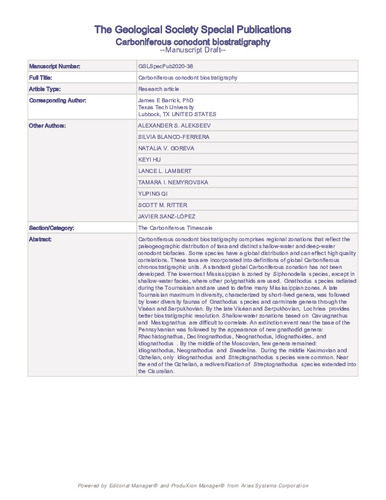Carboniferous conodont biostratigraphy
Editor/Coord./Trad.:
Palabra(s) clave:
Conodont
Carboniferous chronostratigraphy
standard zonation
regional zonation
palaeogeography
Fecha de publicación:
Editorial:
The geological Society London
Citación:
Descripción física:
Resumen:
Carboniferous conodont biostratigraphy comprises regional zonations that reflect the palaeogeographical distribution of taxa and distinct shallow-water and deep-water conodont biofacies. Some species have a global distribution and can effect high quality correlations. These taxa are incorporated into definitions of global Carboniferous chronostratigraphic units. A standard global Carboniferous zonation has not been developed. The lowermost Mississippian is zoned by Siphonodella species, excepet in shallow-water facies, where other polygnathids are used. Gnathodus species radiated during the Tournaisian and are used to define many Mississippian zones. A late Tournaisian maximum in diversity, characterized by short-lived genera, was followed by lower diversity faunas of Gnathodus species and carminate genera through the Visean and Serpukhovian. By the late Visean and Serpukhovian, Lochriea provides better biostratigraphic resolution. Shallow-water zonations based on Cavusgnathus and Mestognathus are difficult to correlate. An extinction event near the base of the Pennsylvanian was followed by the appearance of new gnathodid genera: Rhachistognathus, Declinognathodus, Neognathodus, Idiognathoides and Idiognathodus. By the middle of the Moscovian, few genera remained: Idiognathodus, Neognathodus and Swadelina. During the middle Kasimovian and Gzhelian, only Idiognathodus and Streptognathodus species were common. Near the end of the Gzhelian, a rediversification of Streptognathodus species extended into the Cisuralian.
Carboniferous conodont biostratigraphy comprises regional zonations that reflect the palaeogeographical distribution of taxa and distinct shallow-water and deep-water conodont biofacies. Some species have a global distribution and can effect high quality correlations. These taxa are incorporated into definitions of global Carboniferous chronostratigraphic units. A standard global Carboniferous zonation has not been developed. The lowermost Mississippian is zoned by Siphonodella species, excepet in shallow-water facies, where other polygnathids are used. Gnathodus species radiated during the Tournaisian and are used to define many Mississippian zones. A late Tournaisian maximum in diversity, characterized by short-lived genera, was followed by lower diversity faunas of Gnathodus species and carminate genera through the Visean and Serpukhovian. By the late Visean and Serpukhovian, Lochriea provides better biostratigraphic resolution. Shallow-water zonations based on Cavusgnathus and Mestognathus are difficult to correlate. An extinction event near the base of the Pennsylvanian was followed by the appearance of new gnathodid genera: Rhachistognathus, Declinognathodus, Neognathodus, Idiognathoides and Idiognathodus. By the middle of the Moscovian, few genera remained: Idiognathodus, Neognathodus and Swadelina. During the middle Kasimovian and Gzhelian, only Idiognathodus and Streptognathodus species were common. Near the end of the Gzhelian, a rediversification of Streptognathodus species extended into the Cisuralian.
Descripción:
El Serpukhoviense en el Palaeotethys Occidental: variaciones climáticas y sus consecuencias sobre las biotas, aspectos paleoambientales, paleogeográficos y bioestratigráficos
ISBN:
ISSN:
Patrocinado por:
S B-F and J S-L would like to thank the support provided by the project CGL2016–78738-P of the Spanish Government.
Colecciones
- Artículos [37548]
- Geología [551]
- Investigaciones y Documentos OpenAIRE [8420]
Ficheros en el ítem





